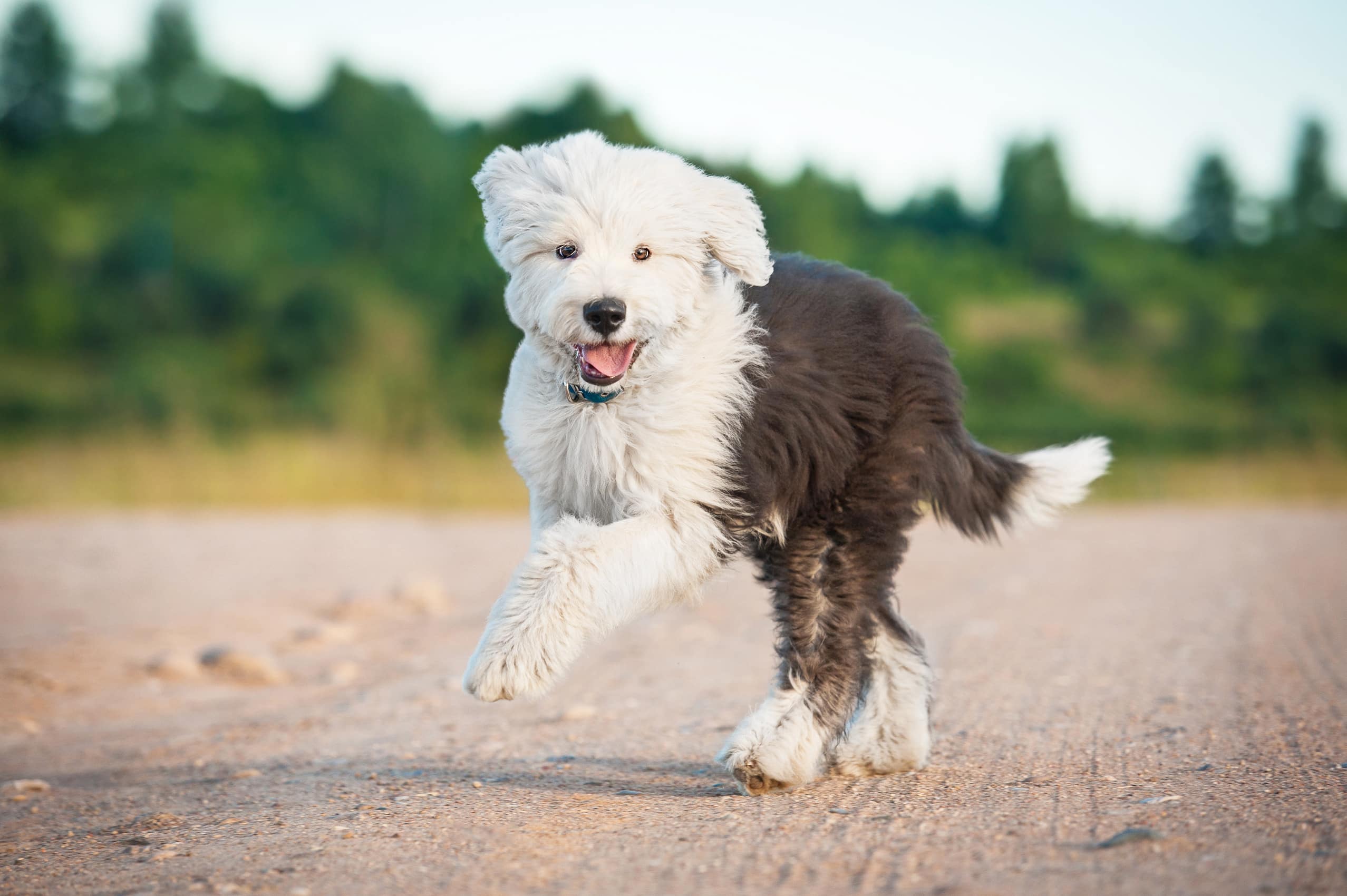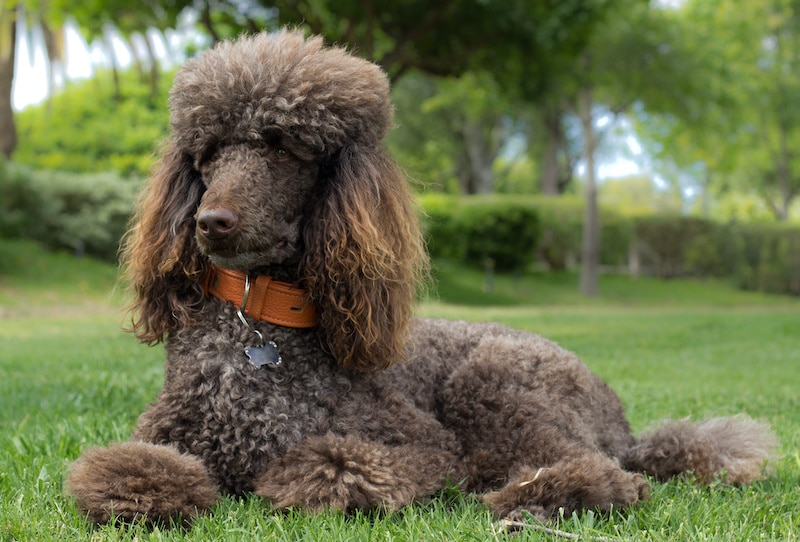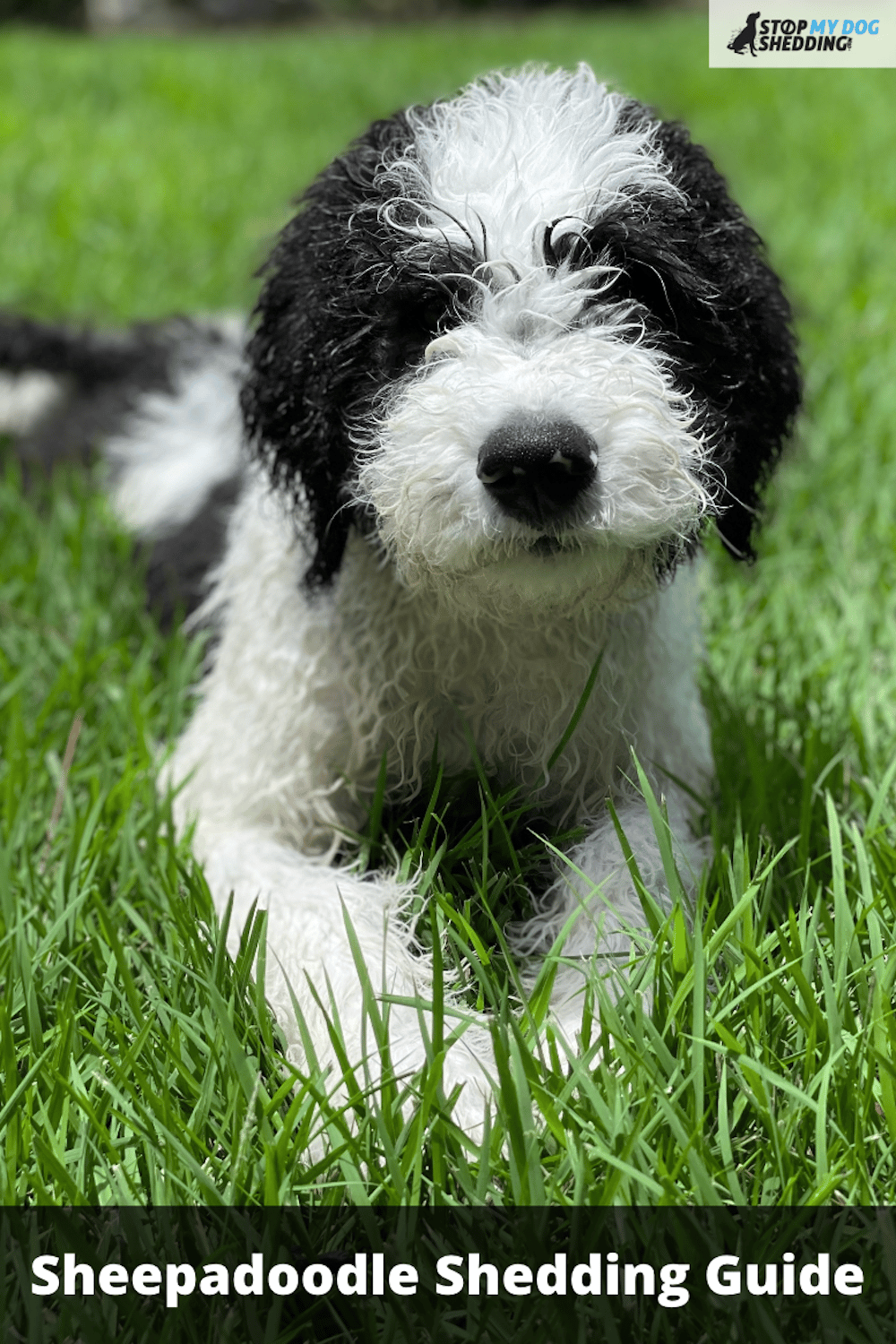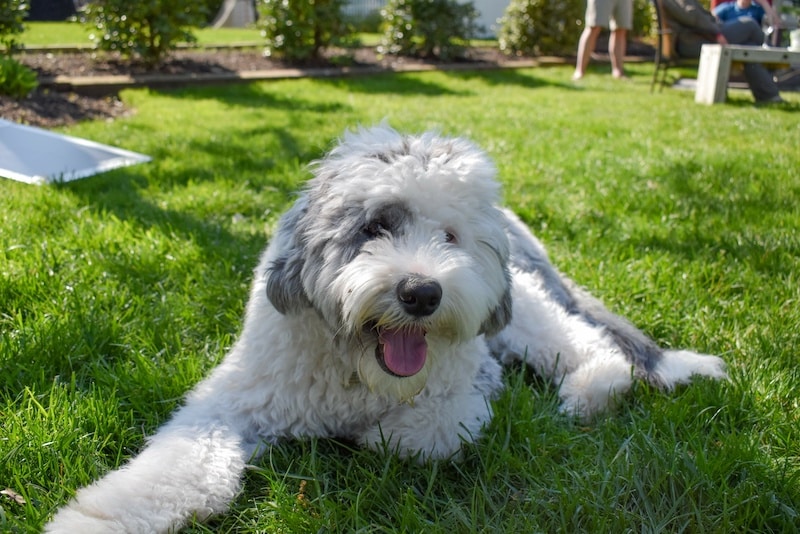Cross between an Old English Sheepdog and Poodle, Sheepadoodles are highly intelligent dogs that are known to make great family companions.
And like many “designer” breeds, they have gained popularity over the years due to having a lower propensity to shed and better suitability for allergy sufferers than the average dog.
How much do they shed?
Sheepadoodles can be very low-shedding dogs. However, as with any mixed breed dog, it’s not quite as simple as saying they are a low, moderate, or heavy shedder in absolute terms. This is because the Sheepadoodle’s rate of shedding will vary depending on its lineage.
Generally speaking, the more Poodle the Sheepadoodle has in its heritage, the lower shedding and more “hypoallergenic” it is likely to be.
In this post, we’ll explore Sheepadoodle shedding further to help you decide if this is the dog you’ve been looking for. I’ll also give you the heads up about what they’re like to groom, and help answer some other common questions people have about this breed.
Recommended: Go here to see our top-rated dog hair blow dryers
Sheepadoodle Shedding Guide
Sheepadoodles are generally considered low-shedding dogs, and this is ultimately thanks to the breed’s Poodle lineage since Poodles are very low shedders.
However, as I mentioned, the rate of shedding in any particular Sheepadoodle dog will ultimately depend on its parents. This is because, on the one hand, Old English Sheepdogs are heavy shedders while, on the other hand, Poodles shed hardly anything.
One easy way to think about it is that a Sheepadoodle will typically shed less than a purebred Old English Sheepdog thanks to introducing Poodle genes into the mix, but they will typically shed more than a purebred Poodle.
So, if your ONLY concern is how much fur they drop, you’d almost be better off adopting a purebred Poodle. But that’d be a shame because Sheepadoodles are a remarkable breed!
Let’s look into the shedding traits of each parent further to get a better idea of what traits the Sheepadoodle inherits. Then, I’ll show you what the lowest shedding Sheepadoodle variety is, talk about how often they shed, and finally, give you some tips on reducing the shedding.
Old English Sheepdog (OES) Shedding

The Old English Sheepdog (OES) is a relatively heavy-shedding breed.
In rate-of-shedding terms, they’re right up there with some of the heaviest shedders in dogdom, like the Leonberger and Saint Bernard.
However, they have two things going for them that many other heavy shedding dogs don’t, and these make the fur loss a lot less extreme and more manageable.
- First, OES’ have long, shaggy coats. And as a result, the hair they lose tends to get trapped in the coat rather than falling onto the floors and furniture. So, while this doesn’t decrease the rate of shedding, it can make keeping your home fur-free a lot easier because most of it will go into the brush rather than fill your home.
- Second, the OES is a double-coated breed, meaning they have two layers: a soft, protective undercoat of fur and a shaggy outer layer of hair. This is noteworthy because double-coated dogs usually “blow coat” (aka shed lots) seasonally twice a year. But not the OES. Instead, they tend to shed on an even keel year-round.
So, even if your Sheepadoodle is predominately OES, fret not.
While the OES is considered a high shedding breed, the above two factors make the shedding a lot more manageable and predictable than most other heavy shedding dogs.
Poodle Shedding

Unlike Old English Sheepdogs, Poodles are very low-shedding dogs.
With the exception of hairless breeds, there’s no such thing as a 100% non-shedding dog. Hair, by its very nature, goes through a growth cycle that sees old hair replaced by new hair.
But Poodles are about as low-shedding as they come, which is one of the main reasons why so many heavy shedding breeds are mixed with it to create “designer” dogs. Introducing Poodle genes will almost always see an otherwise heavy shedding dog drop less hair.
For example, here are some popular designer dogs:
- Labradoodle (Poodle cross Labrador)
- Bernadoodle (Poodle cross Bernese Mountain Dog)
- Aussiedoodle (Poodle cross Australian Shepherd)
- Goldendoodle (Poodle cross Golden Retriever)
These dogs are commonly referred to as “Doodles” because the term “doodle” is placed at the end of the non-Poodle parent’s breed name.
In any case, aside from being low shedders, Poodles are also generally considered to be “hypoallergenic,” meaning they are generally more tolerable for people with pet allergies. And this is one of the reasons “doodles” have become such a popular hybrid dog.
Not to mention, Poodles come in three sizes (toy, miniature, and standard), so breeding larger dogs with a Poodle can not only make them shed less and be more allergy-friendly, but it can allow breeders to develop smaller hybrid versions of an otherwise large dog.
What’s the Lowest Shedding Sheepadoodle Variety?
The lowest-shedding variety of Sheepadoodle will be the one with more Poodle in it. But there are specific classifications of Sheepadoodle that can give you a better idea of what to look for when discussing what you want with a breeder or wherever you end up adopting from.
Here are the main varieties of Sheepadoodle:
- F1 (low shedding): The F1 Sheepadoodle is a cross between a purebred Poodle and a purebred Old English Sheepdog, making it 50% Poodle and 50% OES.
- F1B (lower shedding): The F1B Sheepadoodle is the result of mixing an F1 Sheepadoodle and a Poodle, making this variety of Sheepadoodle 75% Poodle and 25% OES.
- F1BB (lowest shedding): The F1BB Sheepadoodle is the lowest shedding variety of all. It’s the result of crossing an F1B Sheepadoodle with a Poodle, which makes it 87.5% Poodle and only 12.5% OES. The upside to this is lower shedding. The downside is that most of the OES has been bred out of it, which is not so good for those who like the OES’ traits.
There are more varieties than that, but beyond the ones I’ve mentioned, it’s mostly not relevant. For example, the F2 Sheepadoodle is a mix of two F1s, which produces essentially the same 50/50 OES/Poodle mix, but with less certainty over what you’ll end up with.
So, getting too technical beyond the F1, F1B, and F1BB doesn’t make a lot of sense.
And besides, the worst case (in terms of shedding) is that you’d end up with a predominately Old English Sheepdog variety of Sheepadoodle. But as I explained earlier, while the OES is a heavy shedder, they don’t shed seasonally, and much of the hair is contained in the shaggy coat.
So even if you end up with a predominately OES variety, the fur is still going to be manageable, and you are still likely to notice less shedding than you would with a purebred OES.
How Can You Stop a Sheepadoodle Shedding?
It’s not possible to stop any dog from shedding completely because this is a normal part of the hair growth cycle, which occurs in four stages.
These stages are known as anagen, catagen, telogen, and exogen, and each represents a distinct phase in which the hair grows, transitions, rests and falls out. From there, the hair is replaced by new hairs, which starts the cycle all over again.
So my point is that hair falling out isn’t necessarily a “bad” thing or something you should try to stop – it’s literally just your dog’s natural hair growth cycle.
That said, there are ways you can reduce the shedding.
And the simplest and most effective methods relate to diet and grooming.
In short, by ensuring your dog’s diet is optimal, you are going to give him the best chance of avoiding unnecessary hair loss, and this can help him develop a healthier, stronger coat.
What food is best? There are some great dog foods on the market that give dogs all the nutrition they need and that are designed to minimize shedding.
However, it’s best to speak with a qualified veterinarian before making any changes to your dog’s diet. A good vet should be able to advise you on what is the most appropriate food for your dog based on how old he is and what he needs (among other things).
As for grooming, this is your next best defense against shedding, and while periodic bathing can make a big difference, removing most of the loose fur will come down to regular brushing.
Not only can brushing remove lots of old fur before it falls off your dog, but it can help spread the natural skin oils and make the coat nice and shiny. So if there is one thing to focus on aside from diet, it’s brushing your Sheepadoodle regularly.
What are Sheepadoodles Like to Groom?
Sheepadoodle coats are usually fairly long (if allowed to grow) and either curly or shaggy or some variation of both. This is because both of its parents have longer coats, and the Poodle’s coat is curly while the Old English Sheepdog’s coat is shaggy.
So, as with shedding, the type of coat your Sheepadoodle has will depend on its lineage and, therefore, what they are like to groom will vary as well.
Generally speaking, though, Sheepadoodles are higher maintenance than most dogs when it comes to brushing and grooming, regardless of whether they’re predominately Poodle or OES.
The main difference is that if your Sheepadoodle takes more after an OES, you may have to contend with an undercoat. So instead of brushing one layer of fur, you’ll be brushing two.
What’s the best brush for a Sheepadoodle?
The ideal brush combination for a Sheepadoodle is a pin brush and slicker brush. And if he has an undercoat, an undercoat rake can be beneficial on occasion.
Here’s a quick overview of each type of brush:
- A pin brush is a regular brush made with thick, widely spaced wire bristles and rubber or plastic tips on the end. And this brush is ideal to start with as it can remove larger debris and help loosen stubborn mats, knots, and tangles.
- A slicker brush is kind of similar but has tighter packed, finer wire bristles that are designed to remove loose fur from your dog’s coat. These are also great for mats and tangles.
- Using an undercoat rake is optional, but these are specifically designed to get right down into the undercoat and remove the old fur, so they can be useful to use every now and then (not daily) if your Sheepadoodle has an undercoat, especially if he sheds.
You can learn more about the different types of dog brushes here. And as for how often you should brush your Sheepadoodle, it’s typically best to brush a few times a week with the pin and/or slicker brush, or more frequently if you notice mats or excess loose hair.
What about bathing?
Bathing your Sheepadoodle once every month or two can be a great way to keep their coat beautiful and remove any old fur. Always use a good quality dog-friendly shampoo, though, as human shampoo can be too harsh for a dog’s coat and cause irritation.
It can also be worth using a proper dog grooming bath as these can help you do a better job, save you time, and have numerous other advantages over using a household bath or outdoor hose.
What about trimming?
Trimming your Sheepadoodle’s coat can be a good idea if you live in a warmer climate, as their coat is quite thick. It is also important to trim them periodically as their hair grows more like human hair (i.e., keeps growing) and can cover their eyes and get tangled.
There are a variety of ways you can trim your Sheepadoodle, and some opt to have it done professionally. But the important thing is to remove enough hair so that it isn’t covering their eyes or otherwise impeding their quality of life.
On the flip side, it’s also important to avoid removing the undercoat if your Sheepadoodle has one. Why? Because the undercoat is what helps keep them insulated from hot and cold weather. So unless your vet recommends it for some reason, it’s best to keep the undercoat.
Are Sheepadoodles Hypoallergenic?
Regardless of what some breeders or sites might say, the fact is that no dog is 100% hypoallergenic, and the reason for this is that it’s typically not the hair itself that causes allergies; it’s the dog’s dander (dead skin cells), saliva, sweat, and urine.
And since ALL dogs produces those things, even hairless breeds, there is no such thing as a truly hypoallergenic breed.
That being said, dander (and the other allergens I mentioned) can attach themselves to your dog’s old hair and “hitch a ride” when that hair falls off and becomes airborne.
So, generally speaking, dogs that shed less tend to spread less dander around the home than their heavy shedding counterparts. And that’s why some Sheepadoodles can be more hypoallergenic than other dogs – because if they have a lot of Poodle in their lineage, they are likely going to shed less hair and, therefore, spread less allergens around the home.
As with shedding, the more Poodle the Sheepadoodle has, the less likely it is going to cause problems if you’re allergic to dogs. But if your main concern is allergies, then a purebred Poodle (or Toy Poodle) may be a better option.
Recommended: Go here to see our top-rated dog hair blow dryers
Related Questions
How Often Do Sheepadoodles Shed?
Sheepadoodles tend to shed at an even rate year-round, and this is mostly because neither the Poodle nor OES shed seasonally. So, to whatever extent your Sheepadoodle sheds, it should be relatively even throughout the year.
Do Mini Sheepadoodles Shed?
A Mini Sheepadoodle is a cross between a Miniature Poodle and OES, and like regular-sized Sheepadoodles, they can shed. However, all else being equal, they will likely shed less because they don’t have as much hair to drop in the first place.
Everything we’ve discussed so far about the Sheepadoodle also applies to the Mini Sheepadoodle; it’s just that the latter variety has less surface area of hair on their body and, as such, can’t produce as much hair as a larger Sheepadoodle.
Do Sheepadoodles Shed Their Puppy Coat?
Sheepadoodles are typically born with a lighter, softer coat and, like most puppies, will shed this as they get older and develop their thicker coat. And they generally lose their puppy coat anywhere from 6-to-12 months of age.
This varies from dog to dog, though. Some puppies can start losing their puppy coats at 12 weeks old, while for others, it can take a bit over a year.
Do Sheepadoodles Drool?
All dogs can drool from time to time, but Sheepadoodles are not considered heavy droolers. So this is yet another bonus for those concerned about how hypoallergenic it is and who don’t want to deal with dog drool everywhere.
Do Sheepadoodles Bark Much?
Sheepadoodles are not known to be excessive barkers, so they aren’t as likely to cause complaints from neighbors compared to some dogs, especially with adequate training.
However, they do like to be around their owners a lot, so leaving them alone for extended periods can cause separation anxiety, which in turn can lead to misbehavior. Although that’s true for a lot of dogs, not just the Sheepadoodle.
What Are Sheepadoodles Like?
Sheepadoodles are highly intelligent dogs that make great family companions. Aside from being smart, their main standout qualities are trainability, athleticism, and a loving disposition.
It’s not known when the Sheepadoodle came about, but according to dogtime.com, they gained popularity in the 1980s due to their tolerance among allergy sufferers.
As for the parents, both the Poodle and OES are considered very smart dogs, and they are both highly trainable, athletic, and make great companions.
Poodles, however, which are one of the oldest dogs in dogdom, were originally bred as water retrievers. In other words, hunting and retrieving waterfowl.
Whereas the OES, whose origins are less clear, are part of the Herding Group, meaning they excel at herding, like the Bearded Collie, which is said to be one of their ancestors. The other difference with an OES is that they are considered easier going than a Poodle.
Aside from all of that, the Sheepadoodle is an incredibly loving dog. And I haven’t managed to find anything else that illustrates this better than the following YouTube video I found about Zammy:
The Sheepadoodle is a truly beautiful, sweet-natured dog.
Oh, and if you’re worried about its size, don’t be. Mini Sheepadoodles are pretty much miniature versions of the same dog, with all the same traits except size.
Conclusion
The Sheepadoodle inherits some of the best traits from both of its parents, the Poodle and Old English Sheepdog. So even though they can be very athletic, they can also be super easygoing and will happily spend time snuggling with you at home.
What’s more, as I’ve explained in this post, they are generally considered low-shedding and can be better suited to those with pet-related allergies than heavier shedders.
Anyway, that’s it from me.
What about you? Do you have a Sheepadoodle?
If so, let us know in the comments below what your experience has been with shedding, grooming, and anything else you’d like to share. Thanks for reading!













Please note: By submitting a comment using the above comment form, you confirm that you agree with the storage and handling of your data by this site as detailed in our Privacy Policy.